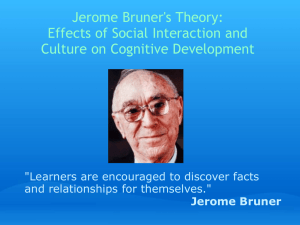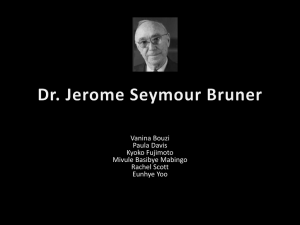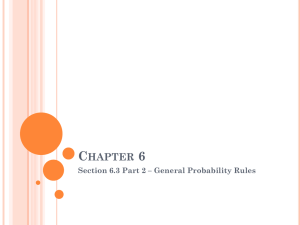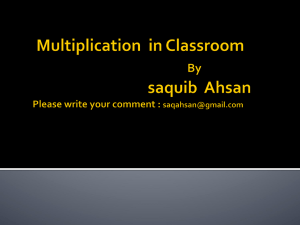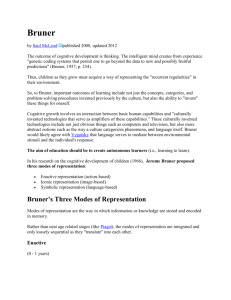Paper 1: Making Connections Between Bruners Theory of Cognitive
advertisement
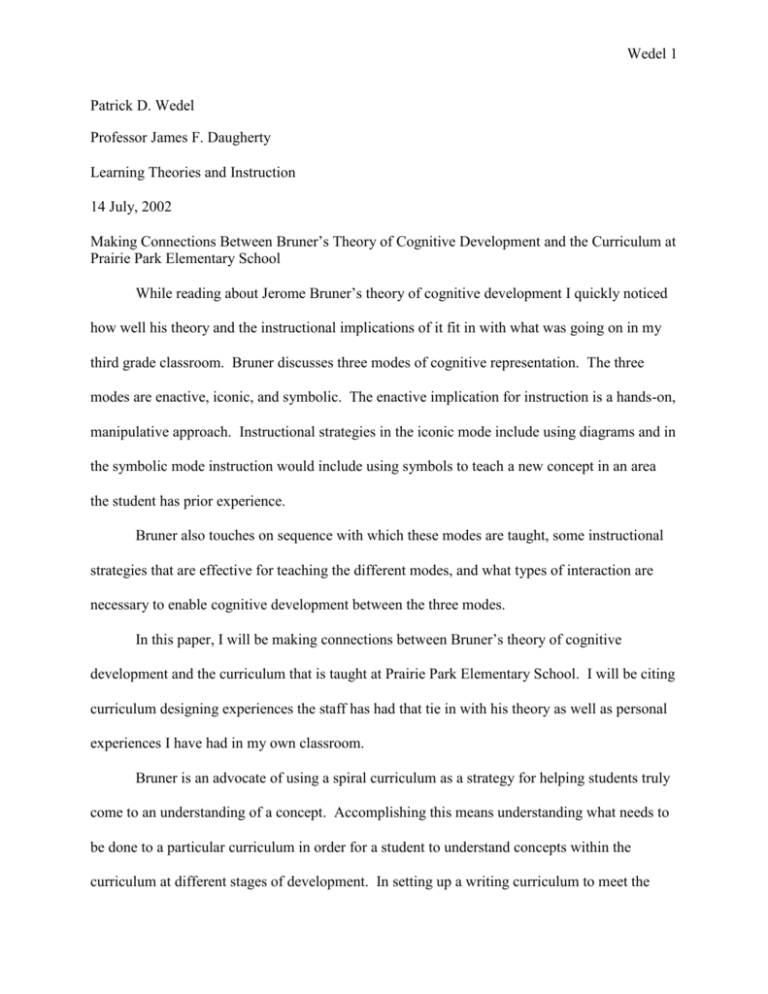
Wedel 1 Patrick D. Wedel Professor James F. Daugherty Learning Theories and Instruction 14 July, 2002 Making Connections Between Bruner’s Theory of Cognitive Development and the Curriculum at Prairie Park Elementary School While reading about Jerome Bruner’s theory of cognitive development I quickly noticed how well his theory and the instructional implications of it fit in with what was going on in my third grade classroom. Bruner discusses three modes of cognitive representation. The three modes are enactive, iconic, and symbolic. The enactive implication for instruction is a hands-on, manipulative approach. Instructional strategies in the iconic mode include using diagrams and in the symbolic mode instruction would include using symbols to teach a new concept in an area the student has prior experience. Bruner also touches on sequence with which these modes are taught, some instructional strategies that are effective for teaching the different modes, and what types of interaction are necessary to enable cognitive development between the three modes. In this paper, I will be making connections between Bruner’s theory of cognitive development and the curriculum that is taught at Prairie Park Elementary School. I will be citing curriculum designing experiences the staff has had that tie in with his theory as well as personal experiences I have had in my own classroom. Bruner is an advocate of using a spiral curriculum as a strategy for helping students truly come to an understanding of a concept. Accomplishing this means understanding what needs to be done to a particular curriculum in order for a student to understand concepts within the curriculum at different stages of development. In setting up a writing curriculum to meet the needs of students at Prairie Park, the staff reflected on what it was we wanted students to know about writing as they left school at the end of sixth grade. We then took the information and dialogued about what this meant for each grade level. For example, it was decided that draft books, in some form, would be used at every grade level from kindergarten through sixth grade. Obviously though, they would not look the same at every grade level. We then discussed what we would want all draft books to have in common. One thing agreed upon were that at all levels, there would be some form of a table of contents. In kindergarten this would mean the teacher actually writing the titles of each piece on the table of contents for each student, but using the term table of contents when explaining what he/she was doing. This particular form of modeling would be consistent with Bruner’s enactive mode of cognitive representation. As students move through the grades teachers will ideally provide less one on one support with more responsibility will fall on the student. As expectations for the table of contents change in the upper primary and intermediate grades, teachers model through a “write to” what the expectations are. These teacher models represent the iconic mode of Bruner’s three modes of cognitive representation. By the time a student is through sixth grade, he/she should be able to independently set up a table of contents that includes the name of the pieces written, date of completion, genre, and page in the draft book where the piece can be found. By this stage, students symbolic system should be well developed and they should be able to explain what they are doing and why they are doing it because of the consistency of instruction they got in the enactive and iconic stages. Although it may be ideal to shape instruction so that it progresses from the enactive , to the iconic, and then finally the symbolic stage it may not always be necessary. Bruner says “When the learner has a well-developed symbolic system, it may be possible to by-pass the first two stages. But one does so with the risk that the learner may not possess the imagery to fall back on when his symbolic transformations fail to achieve a goal in problem solving.”(Bruner, 1966, p.49, quoted in Driscoll, 2000). Upon reflecting on this statement, I could think of several instances when I saw this happen, especially in mathematics. Multiplication is one of many new mathematical concepts introduced in the third grade. Typically, teaching kids the concept of multiplication follows right along Bruner’s the three modes of cognitive development in sequence. First, the enactive mode of instruction is used by introducing the concept of multiplication through manipulatives. For example, a teacher may model using two groups of three unifix cubes to show 2x3 and then have the students model the same behavior. The iconic mode may be demonstrated by the teacher modeling making two sets of three dots to show 2x3 and then closely observing as the students work independently on an activity that requires them to do the same. Simply showing students that 2x3=6 would be an example of instruction in the symbolic mode. It seems that every year I have at least one student who comes into third grade knowing their multiplication facts, but not understanding the concept of multiplication. Through drill and practice they have memorized that 2x3=6, but they couldn’t tell you what that meant. This lack of understanding the concept of multiplication often catches up with them when they are required to solve a story problem involving multiplication. When students come to me showing they already know their multiplication table I often give them challenge work when the rest of the class is being introduced to multiplication. These students may breeze through a sheet of multiplication problems, but they may be stumped by a story problem that asks “How much money does Timmy earn if he makes $5 a day three days in a row?”. Students familiar with physical representations of multiplication have that enactive representation, and the iconic representation as well, to fall back on when they have such story problems. In referring to Bruner’s recommendation that the teaching of fractions should include plenty of activities in the enactive and iconic modes Dricoll states “Although it is time consuming, having students solve many such problems, from enactive to symbolic modes, will ensure a deep understanding of the concept and the ability to apply it appropriately in many contexts”(228). I believe this philosophy is equally important in teaching multiplication, or any other math concept. It is also a philosophy that is modeled to new teachers in math staff development. According to Bruner moving from one mode of cognitive representation to another requires interaction. Driscoll cites three different forms of interaction. There is interaction between genetic predispositions and experience. Learners may be predisposed, for example, to representing their experience in iconic modes, but with appropriate medium-level questions from a tutor, be brought to a symbolic understanding of some idea. There is also interpersonal interaction; learning is a social enterprise. And there is interaction of the individual with the cultural. Indeed, culture provides the backdrop against which all forms of interaction play. (229) Bruner states that discovery learning is very important to cognitive development and the interactions mentioned can all occur within the strategy of discovery learning. True discovery requires finding regularities and relationships in the environment. Teaching discovery can be in the form of concept attainment. My personal experience with concept attainment teaching is that it is a very effective method of helping students to see regularities and relationships. One concept attainment lesson in particular that I have always had success with is one on the moon. For this lesson, students are put into groups. Each group has a recorder that is required to jot down any and all ideas members of his/her group mention. I then write down “Yes” and “No” at the top of the board. For the first round, I write down two facts about the moon. Within their groups, students discuss what I could possibly be talking about and the recorder writes down all ideas. The next time around I may add a couple more facts to the “Yes” side and one or two things to the “No” side. Students again discuss within their groups. Often, more ideas are added and sometimes an idea or two may be crossed off. This goes on until there are enough clues on the “Yes” side to narrow it down to only one possible answer. This lesson is always followed with some form of assessment to check for understanding. I’m always amazed at what students are able to recall and the connections they are able to make through the entire space unit.

